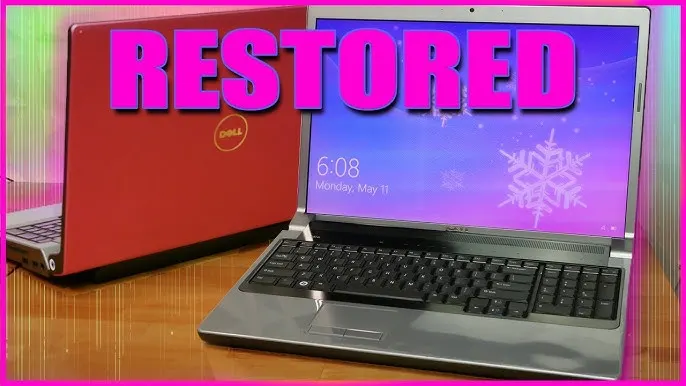How to Revive an Old Laptop: 6 Tips to Speed Up Your Slow Computer
Do you have an old laptop gathering dust in a corner? Are you looking for ways to breathe new life into it?
Fortunately, reviving an old laptop is easier than you might think. In this blog post, we'll share a step-by-step guide that will help you bring your aging machine back to life.
We'll cover everything you need to know, from hardware upgrades to software optimization. So, roll up your sleeves and get ready to transform your old laptop into a powerful and efficient device once again. Let's dive right in.
How to Revive an Old Laptop
Restart your PC
Have you tried turning it off and on again? It may sound cliché, but restarting your laptop can help improve its performance.
You can clear out any temporary files or processes causing slowdowns by shutting down and rebooting your PC. It only takes a minute and can make a noticeable difference in your laptop's speed.
Clean startup applications
When you boot up your laptop, many applications automatically launch in the background. Over time, these startup apps can accumulate and slow down your computer's performance.
To clean up your startup applications, open the Windows Settings app and search for "Startup apps." You will see a list of apps that launch when Windows starts up. Disable any unnecessary applications to free up system resources and improve boot times.
Check your Internet connection.
A slow Internet connection can also contribute to a sluggish laptop experience. Tasks like web browsing, video streaming, and online gaming require a healthy and stable internet connection. To check your Internet connection, use a speed test utility like speedtest.net.
Run the test multiple times and record your ping time, download speed, and upload speed. Ideally, you should have a ping time in the single digits and download and upload speeds above 10Mbps.
If you're experiencing inconsistent or slow internet speeds, consider troubleshooting your wired or wireless connection using relevant guides.
Free up RAM
Your laptop's random access memory (RAM) is its short-term memory, affecting how efficiently it can handle tasks and run programs. If your laptop runs out of RAM, it has to draw data directly from the hard drive, which is slower.
To free up RAM, open the Task Manager utility by pressing Control + Alt + Delete and selecting Task Manager. In the Task Manager, you can see active programs and how much memory they consume.
End tasks for applications that use significant memory to free up resources. Be aware that closing an application using Task Manager will instantly close it, potentially causing you to lose unsaved data. Using Task Manager to free up RAM is a temporary solution and can help identify memory-hogging applications.
Free up space on your hard drive
An entire hard drive can slow down your laptop. When your storage is almost complete, it can hinder the performance of your applications and the operating system.
To free up space on your hard drive, open the Windows Settings app, go to System, and select Storage. This menu provides a breakdown of how your storage is used. Uninstall large apps and delete unnecessary files to create more space.
The Windows Storage menu may not detect some programs, in which case they may be listed under "Other." Check both sections when freeing up space on your hard drive.
Run Windows Update
Windows updates often include critical bug fixes, security patches, and performance improvements. Running Windows Update can help optimize your laptop's performance by ensuring that you have the latest drivers and updates installed.
To run Windows Update, open the Windows Settings menu, select Updates & Security, and click on Windows Update. Download and install any pending updates. Note that some updates may require a restart to complete the installation process.
Upgrade your laptop's RAM.
If your laptop is still sluggish after trying the previous tips, upgrading its RAM may be a solution. Adding more RAM can improve your laptop's multitasking capabilities and overall performance.
However, not all laptops are built to allow RAM upgrades, so it's essential to check your laptop's manual or manufacturer's website to determine if an upgrade is possible. Consult a guide on how to add RAM to your specific laptop model to ensure a successful installation.
Upgrade to a solid-state drive.
If your laptop has a traditional hard disk drive (HDD), consider upgrading to a solid-state (SSD). SSDs are faster and more reliable than HDDs, which can significantly improve your laptop's overall speed and responsiveness. However, not all laptops are designed to support SSD upgrades, so check your laptop's manual or manufacturer's website for compatibility information. A guide on replacing your laptop's hard drive with an SSD can provide step-by-step instructions for the upgrade process.
Consider replacing your laptop
If your laptop is still slow and outdated despite trying the above tips, it may be time to consider replacing it. Technology advances rapidly, and older laptops may be unable to keep up with modern software and applications.
Before purchasing a new laptop, research the best options based on your budget and needs. Consider processor speed, RAM capacity, storage space, and battery life. Additionally, think about how you can responsibly dispose of your old laptop, such as recycling it at a local recycling center or contacting the manufacturer for recycling options.
Conclusion
In conclusion, there are several steps you can take to improve the performance of your old laptop. Restarting your PC can help clear out temporary files and processes that may slow it down. Cleaning up startup applications can free up system resources and improve boot times.
Checking your internet connection and troubleshooting any connectivity issues can ensure a smooth online experience. Freeing up RAM by closing memory-hogging applications can temporarily enhance your laptop's performance.
Additionally, creating more space on your hard drive by uninstalling unnecessary apps and deleting files can prevent storage-related slowdowns.
